Indulge in Homemade Pączki: Your Ultimate Guide to Traditional Polish Fat Tuesday Donuts
These traditional Pączki are the quintessential treat for Fat Tuesday, offering a delectable journey into Polish culinary heritage. With their incredibly tender, butter-enriched dough and a variety of sweet, bursting fillings, these golden-brown delights are more than just a dessert – they are a cherished tradition, perfectly suited for celebrating the festive Mardi Gras season. One bite of these pillowy, jam-filled pączki, often dusted with powdered sugar or coated in a sweet glaze, and you’ll instantly understand why they are so beloved and absolutely worth the effort of making them yourself. They truly capture the spirit of pre-Lenten indulgence with their rich flavor and satisfying texture.
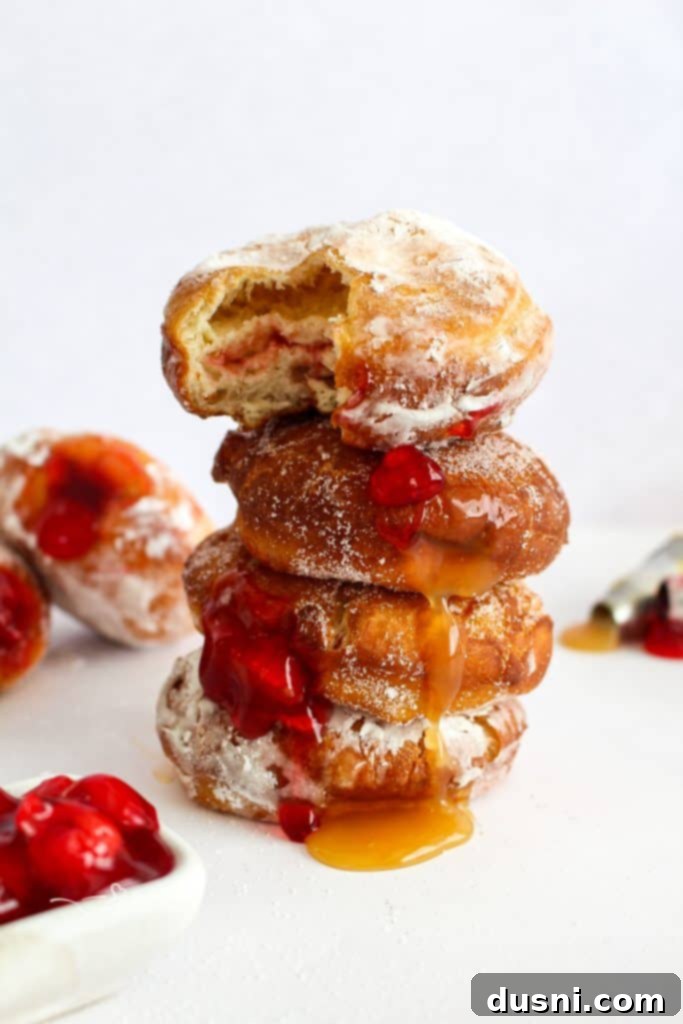
As someone who deeply appreciates rich culinary traditions, it felt essential to share this scrumptious heritage of Pączki. My journey with this recipe began back in 2020 when I was fortunate enough to receive an old Polish cookbook as a gift. As I carefully flipped through its well-worn pages, marking recipes that caught my eye, I knew immediately that these unique Polish donuts would be the first culinary adventure I embarked upon. The allure of creating something so deeply rooted in culture, right in my own kitchen, was irresistible.
Instead of merely searching “Paczki near me” and buying them from a bakery, I decided to immerse myself in the process of making them from scratch. What an incredible and rewarding experience it has been! This recipe has become a cherished staple in our home ever since, bringing joy and a taste of history to our celebrations.
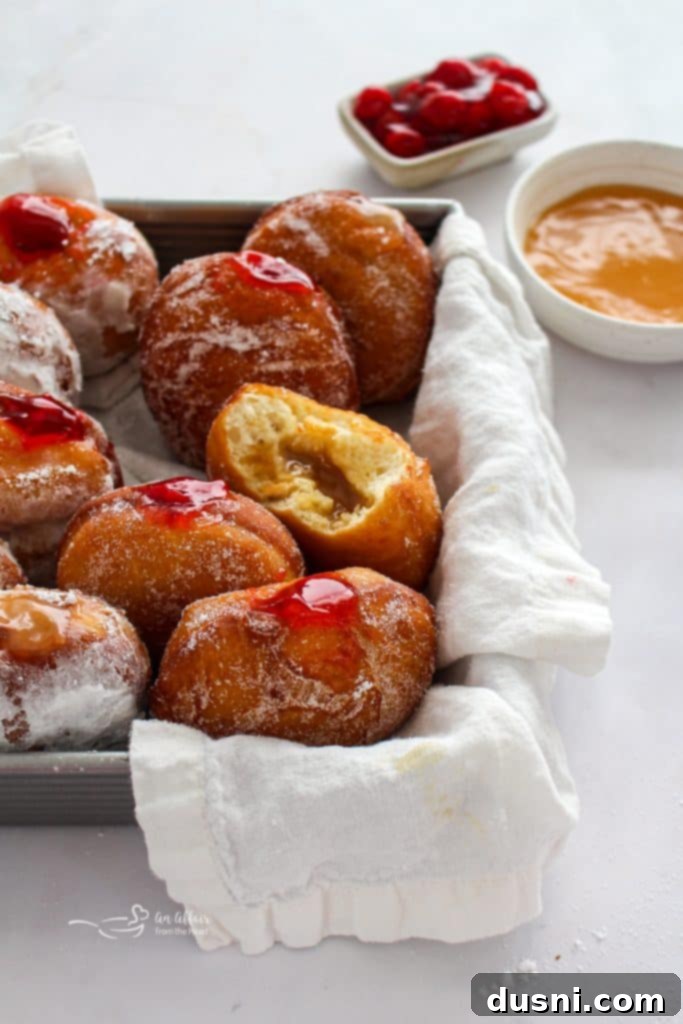
What Are Pączki? Discovering the Rich History of Polish Donuts
Pączki (pronounced “POONCH-key”) are much more than just ordinary donuts; they are a deeply ingrained culinary tradition that has flourished in Polish culture since the Middle Ages. These delectable deep-fried pastries are crafted from a remarkably rich, yeast-leavened dough, generously enriched with eggs, butter, and sometimes even a touch of spirits like rum or vodka. This unique combination of ingredients results in an exceptionally tender, almost brioche-like texture that sets them apart from typical donuts. Once fried to a perfect golden-brown, they are traditionally filled with an array of sweet preserves, such as stewed plum jam (powidła), rose hip jam, or modern favorites like raspberry preserves or creamy custard. A final flourish of either powdered sugar or a sweet glaze completes these indulgent treats.
Historically, Pączki were created as a practical way to use up all the rich ingredients – eggs, sugar, butter, and lard – in the household before the lean fasting period of Lent began. This tradition of pre-Lenten feasting highlights their significance as a symbol of indulgence and celebration before a time of abstinence. Their creation is a testament to resourceful cooking and a love for good food, even centuries ago. If you enjoy the delightful richness of these Polish donuts, you’re sure to love other sweet treats like Baked Glazed Lemon Donuts, Double Chocolate Baked Donuts, Chocolate Kraut Doughnuts, and my easy Air Fryer Biscuit Donuts.

How to Pronounce Pączki (and Why It Matters!)
One of the most frequently asked questions about these beloved Polish doughnuts is how to say their name correctly. Understanding the pronunciation is key to appreciating their cultural authenticity. The plural form, Pączki, is pronounced “POONCH-key.” The singular form, pączek, is pronounced “POON-check.” The little tail under the ‘a’ (ą) is a nasal vowel, sounding like ‘on’ or ‘un’, while the ‘cz’ sounds like ‘ch’ in English. You’ll hear this word spoken frequently around Fat Tuesday and Mardi Gras, particularly in regions with strong Polish communities where “Paczki Day” celebrations are a cherished annual event. Mastering the pronunciation is a small but significant way to honor the rich Polish heritage these delicious treats represent.
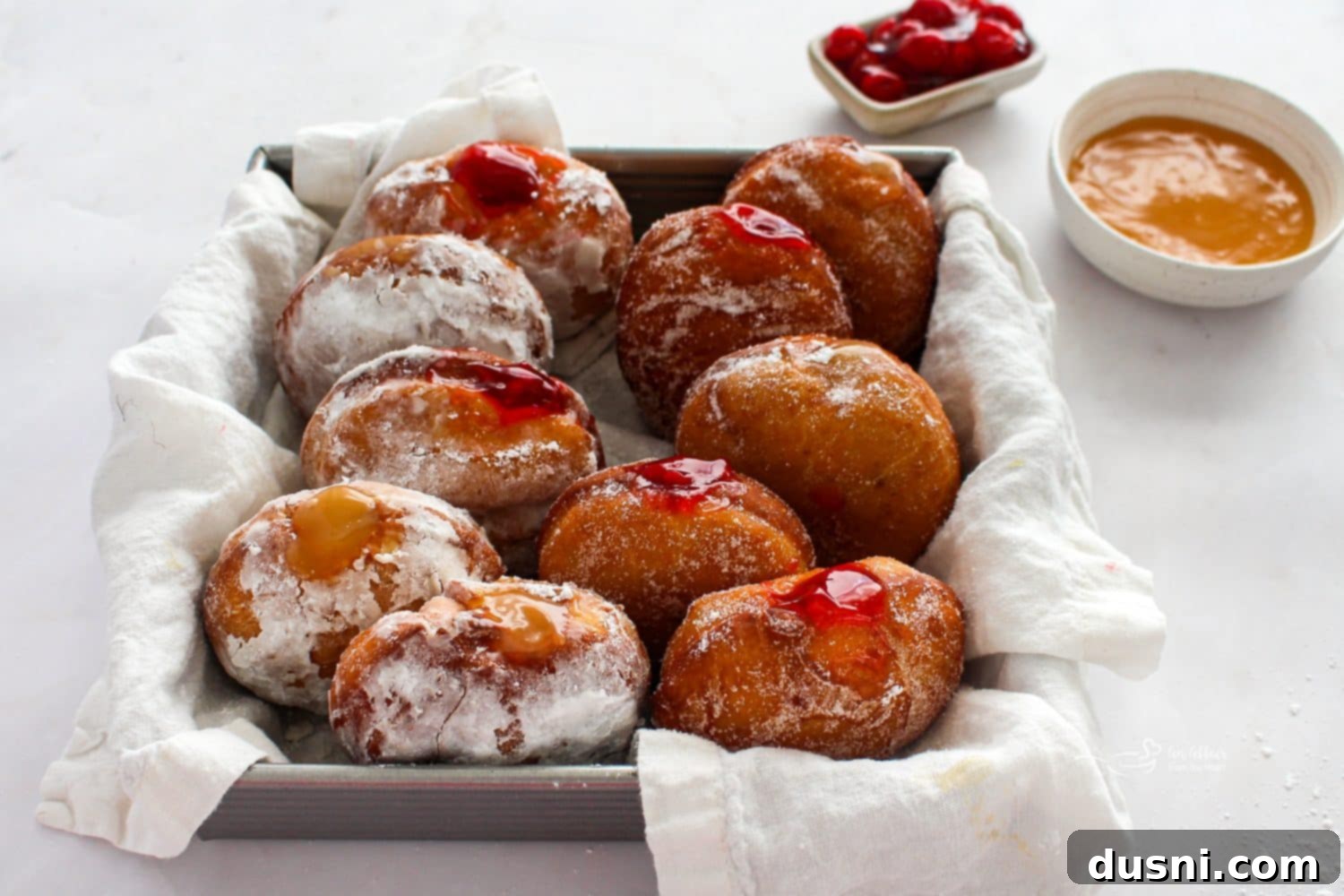
Pączki vs. Donuts: Unpacking the Delicious Differences
While pączki might visually resemble the familiar jelly doughnuts found in many parts of the world, there are distinct differences that make them uniquely special and a celebrated part of Polish cuisine. The primary distinction lies in the dough itself. Traditional pączki are made with an exceptionally rich dough, which includes a significantly higher proportion of egg yolks and butter compared to standard American donuts. This generous enrichment gives them a denser, more substantial, and ultimately, a more luxurious, brioche-like texture. Furthermore, historically, authentic pączki were fried in lard, imparting a unique depth of flavor, though for modern convenience, our recipe uses vegetable oil.
Unlike their lighter American counterparts, pączki typically have less air within their structure and offer a heartier, more satisfying bite. A tell-tale sign of a perfectly fried pączek is the visible “white ring” around its middle, indicating that the dough has risen beautifully and cooked evenly. The filling, too, is often more generous and decadent – a truly good pączek should feel like it’s bursting with sweet preserves or cream. This inherent richness wasn’t just for flavor; it was intentionally designed to use up all the valuable eggs, sugar, and fat in the household before the solemn fasting period of Lent began, making them the ultimate pre-Lenten indulgence.
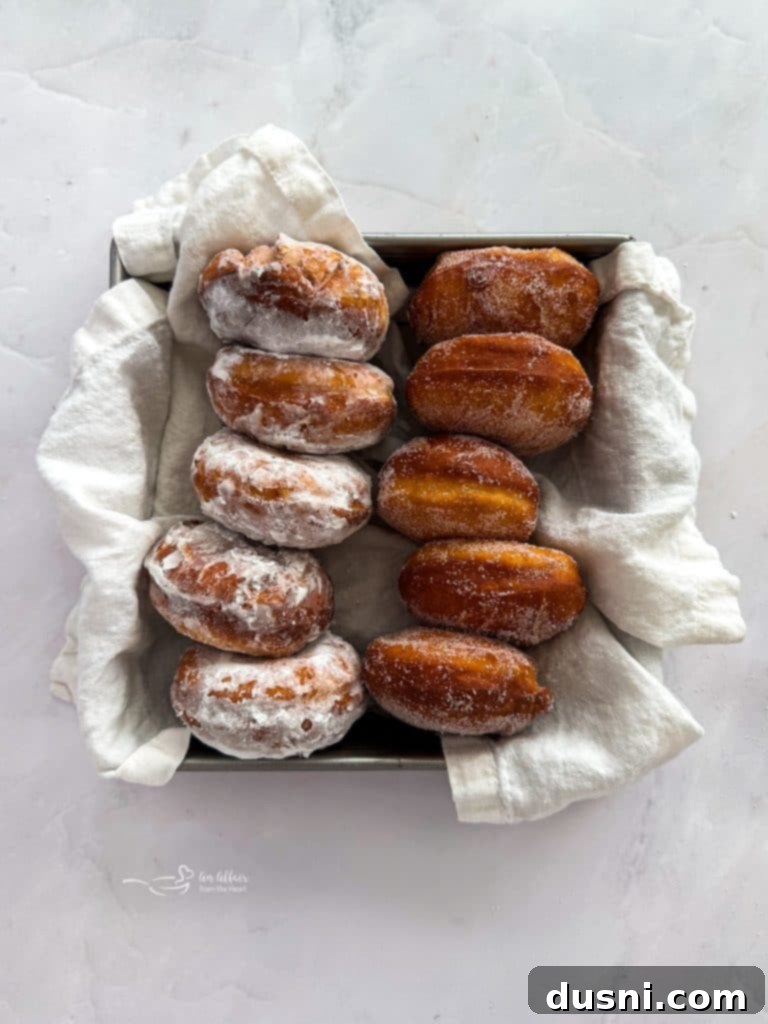
When Are Pączki Eaten? Celebrating Tłusty Czwartek and Fat Tuesday
The timing of when pączki are enjoyed is deeply intertwined with religious and cultural calendars. In Poland, these delightful pastries are traditionally consumed on Tłusty Czwartek, which translates to “Fat Thursday.” This day falls on the last Thursday before Ash Wednesday, marking the jubilant beginning of the final week of pre-Lenten celebrations. It’s a day when Poles traditionally indulge in rich foods, often eating hundreds of thousands of pączki across the country.
In the United States, however, these beloved Polish donuts have become more commonly associated with Fat Tuesday, also known as Shrove Tuesday or Mardi Gras. This day, always the day before Ash Wednesday, serves the same purpose as Fat Thursday in Poland: a final chance for indulgence and feasting before the 40 days of Lenten fasting commence. The tradition of eating pączki during this time is not accidental; it’s a practical and delicious way to deplete rich household ingredients like eggs, sugar, and lard before the Lenten fast. Today, Polish bakeries and grocery stores across the United States, especially in areas with large Polish-American populations like Chicago, Detroit, and Cleveland, sell thousands of pączki in the days leading up to Lent, turning it into a widespread celebration of Polish heritage and delicious food.
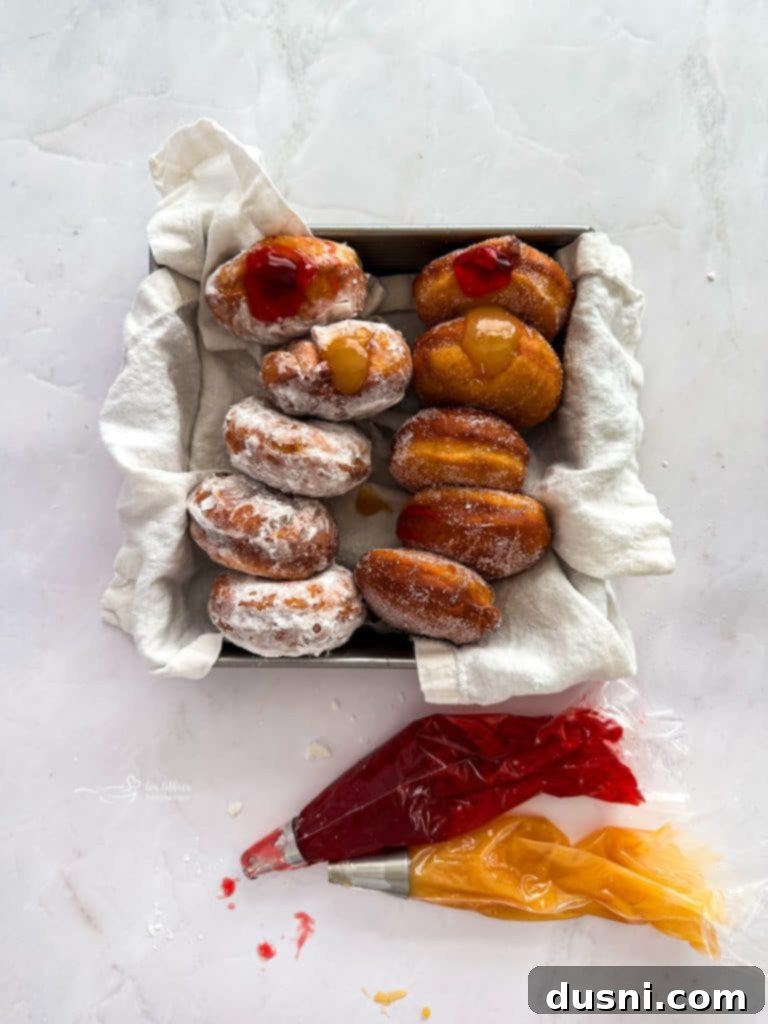
Delicious Fillings for Your Homemade Pączki
One of the most exciting aspects of making pączki at home is the opportunity to customize them with your favorite fillings. While traditional pączki fillings often include historical varieties like rose hip jam (a classic Polish choice), prune butter (known as powidła), and stewed plum jam, modern versions offer a nearly endless array of possibilities to suit every palate. Here are some popular and delightful fillings you might want to try, blending classic tastes with contemporary favorites:
- Raspberry Jam: A vibrant and tangy modern favorite that offers a delightful contrast to the rich dough.
- Custard Filling: Smooth, creamy, and wonderfully sweet, a custard-filled pączek is pure bliss.
- Lemon Curd: A zesty and bright option that adds a refreshing citrus note.
- Bavarian Cream: A rich, vanilla-flavored cream that provides a luxurious indulgence.
- Strawberry Preserves: Sweet and familiar, a comforting classic for any donut.
- Apple Butter: A spiced, fruit-forward filling that evokes warmth and tradition.
- Blueberry Preserves: A sweet-tart burst of berry flavor.
- Sweet Cheese (Twaróg): A traditional Polish farmer’s cheese filling, subtly sweet and creamy, offering a different texture profile.
The beauty of making your own pączki is that you have complete creative control. You can stick to authentic options or experiment with any jam, cream, or fruit curd that tantalizes your taste buds!
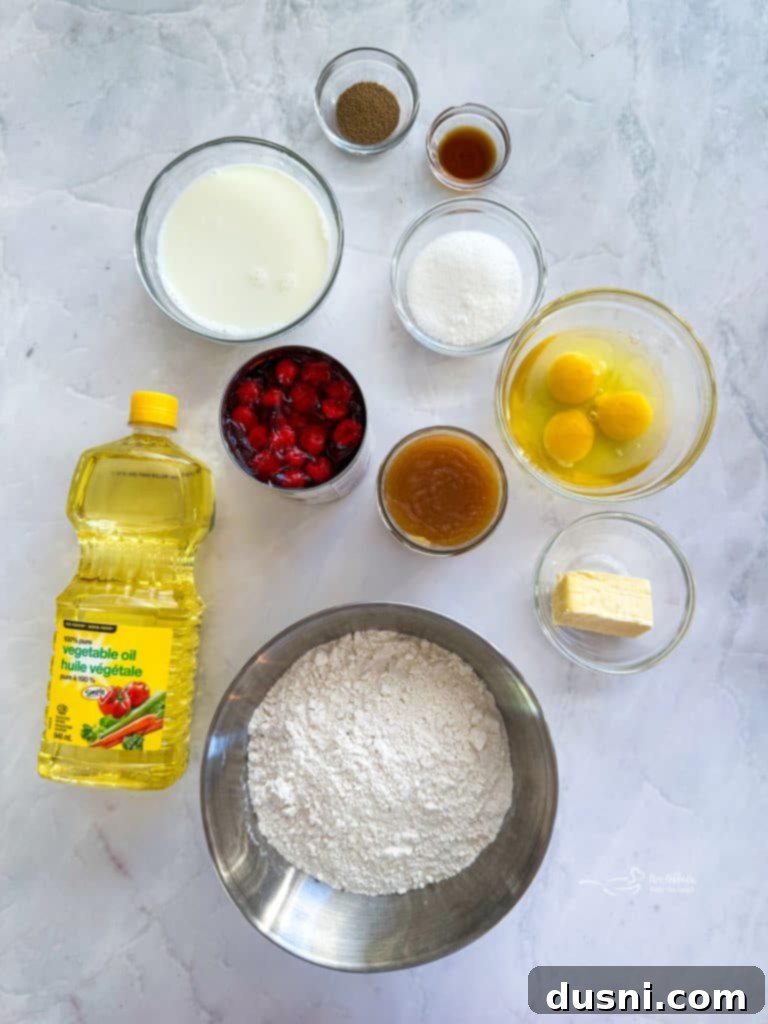
Essential Ingredients for Authentic Pączki
Crafting the perfect Pączki begins with selecting quality ingredients that contribute to their distinctive richness and tender texture. For the complete list of ingredients and detailed instructions, please refer to the full printable recipe further down this post.
- Scalded Milk: Heating the milk to a high temperature and then cooling it creates an ideal environment for yeast activation, enhancing the dough’s elasticity and contributing to pączki’s signature soft, light texture.
- Unsalted Butter: Using room temperature unsalted butter is crucial for smooth incorporation into the dough, adding incredible richness and flavor without introducing excess salt.
- Granulated Sugar: Provides just the right amount of sweetness to the dough itself, balancing the richness of the butter and eggs.
- Vanilla Extract: A splash of vanilla adds depth and warmth, beautifully complementing both the dough and the sweet fillings.
- Active Dry Yeast: This essential leavening agent is responsible for the airy, fluffy texture of the pączki. Ensure your yeast is fresh and active for the best rise.
- Large Eggs: Using large eggs, also at room temperature, ensures proper emulsification and adds richness, structure, and a beautiful golden hue to the dough.
- All-Purpose Flour: The foundation of our dough. The exact amount may need slight adjustment based on humidity and how your flour absorbs liquid, so it’s always good to have a little extra on hand.
- Vegetable Oil for Deep Frying: Essential for achieving that perfect golden-brown exterior. Canola oil or peanut oil are excellent alternatives due to their high smoke points.
- Filling Options: Your choice of jam, custard, or lemon curd. Traditional choices include rose hip or plum jam, but modern varieties are equally delicious.
- Sugar Coating: Granulated sugar or confectioners’ sugar for rolling the warm pączki, providing a sweet, irresistible finish.
Keep reading to discover valuable tips and tricks, potential substitutions, and answers to common questions you might have about this delightful Pączki Polish Donut Recipe.
How to Make Homemade Pączki Polish Doughnuts: A Step-by-Step Guide
This recipe for traditional Polish Pączki requires a bit of time and patience, but I assure you, the incredibly delicious and authentic results are well worth every moment of effort!

Step 1: Prepare the Dough Base. Begin by scalding your milk in a saucepan over medium heat until small bubbles form around the edges. This process denatures proteins in the milk, which helps to create a softer dough. Remove it from the heat and allow it to cool to a lukewarm temperature of 110 degrees F (about 43 degrees C). In the bowl of your stand mixer, combine the cooled milk, room temperature butter, sugar, and vanilla extract. Attach the whisk attachment and mix until the sugar is fully dissolved and the butter is thoroughly incorporated, creating a smooth, creamy base. Next, sprinkle one package of active dry yeast over the mixture and mix again briefly until the yeast is dissolved. This activates the yeast, preparing it to leaven your dough.
Step 2: Add Eggs and Flour. Scrape down the sides of the bowl to ensure all ingredients are well combined. Add each large egg, one at a time, mixing well after each addition until it is fully incorporated into the dough. This step is crucial for building the rich structure of the pączki. Once the eggs are in, switch to the dough hook attachment on your mixer. Turn the mixer to a low speed (typically speed 2) and gradually add the all-purpose flour, a little at a time. The amount of flour can vary slightly depending on humidity, so add it until the dough comes together and is smooth, elastic, and pulls away from the sides of the bowl. You may not need all 4 cups, or you might need a touch more – observe the dough’s consistency carefully.
Step 3: First Rise. Remove the smooth dough ball from the mixer. Lightly spray the inside of the mixer bowl with non-stick cooking spray, then return the dough ball to the bowl. Spray the top of the dough ball with a bit more non-stick spray to prevent it from drying out. Cover the bowl securely with a clean kitchen towel or plastic wrap. Place the covered bowl in a warm, draft-free spot and allow the dough to rise for approximately 1 hour, or until it has visibly doubled in size. A warm oven (turned off) or a sunny spot in your kitchen works perfectly. If your house is particularly cold or drafty, finding an insulated spot will greatly assist the rising process, such as a slightly warmed oven (turned off after warming) or a specific warm spot in your kitchen as suggested by resources like Grant Bakes.
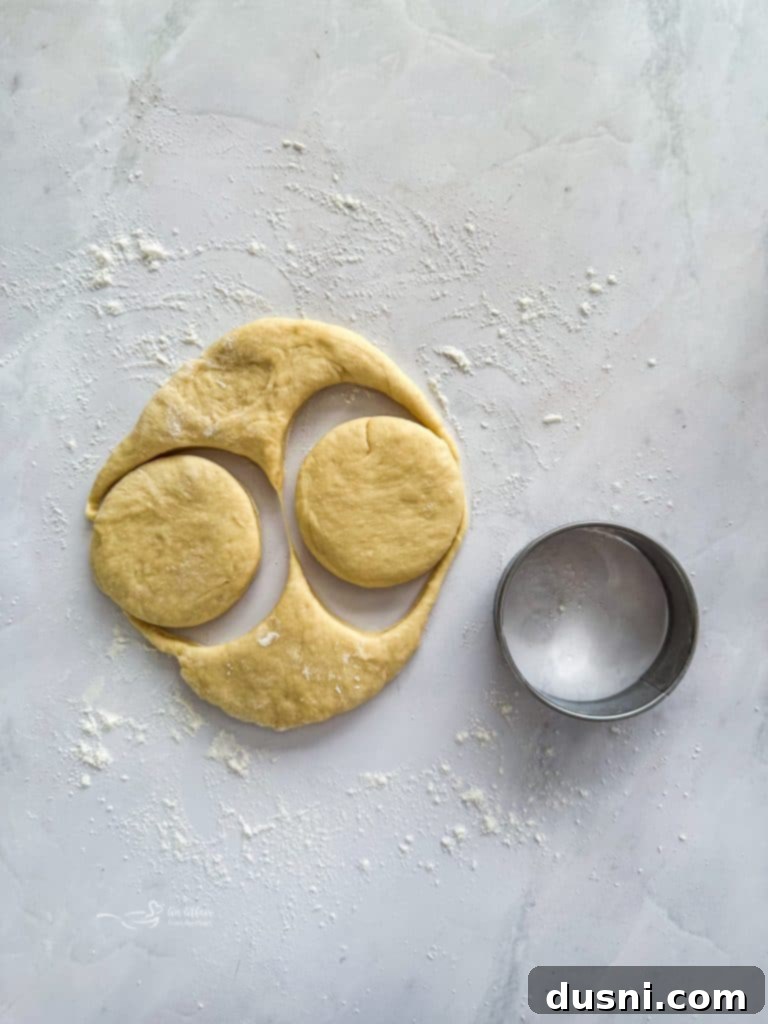
Step 4: Roll and Cut the Dough. Once the dough has beautifully risen and doubled in size, gently punch it down to release the air. Take portions of the dough at a time and place them on a lightly floured surface. Using a rolling pin, roll the dough out to an even thickness of about 1/2-inch to 3/4-inch. Thicker dough will result in more substantial pączki. Using a 3-inch biscuit cutter or a glass of similar diameter, cut out individual circles. Re-roll any dough scraps and continue cutting until all the dough is used. Carefully transfer these rounds to a cookie sheet lined with parchment paper, leaving some space between each one.
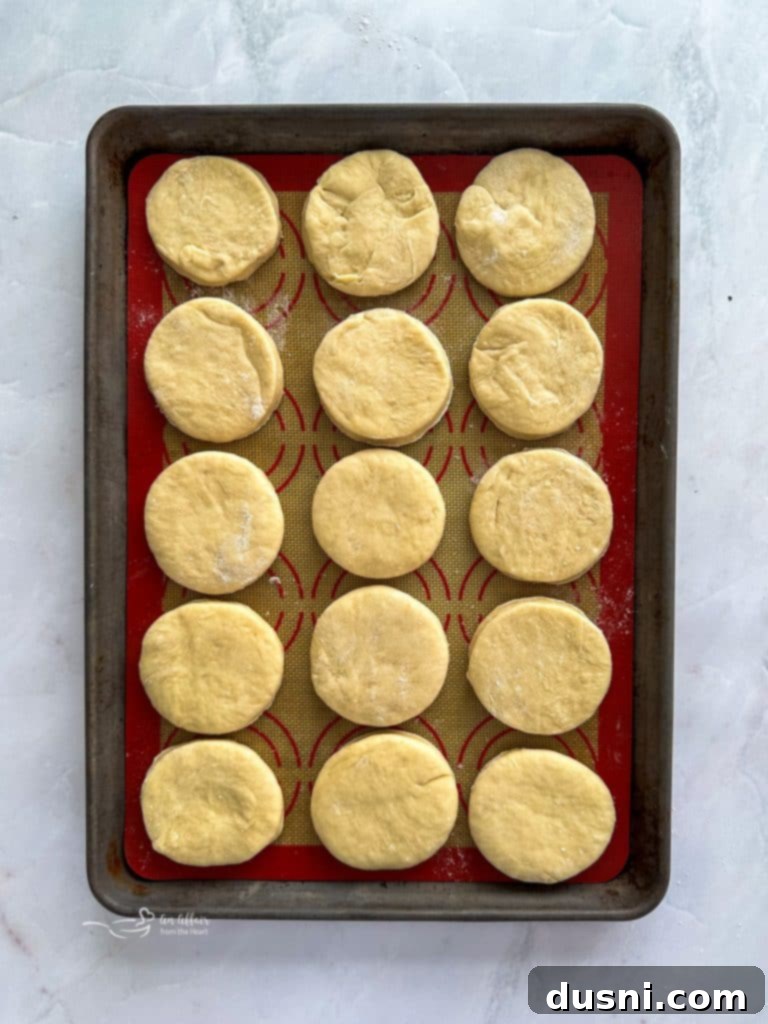
Step 5: Second Rise. Lightly cover the cookie sheet with the cut dough rounds using a clean kitchen towel. Allow them to rise again for another 30 minutes in a warm, draft-free place. This second rise is crucial for developing their airy texture and achieving the coveted “white ring” around the fried pączki.
Step 6: Prepare for Frying and Filling. While your dough is undergoing its second rise, prepare your frying station. Fill a heavy-bottomed pot, such as a cast iron Dutch oven, with about 3 inches of vegetable oil (or canola/peanut oil). Set aside your chosen sugar (granulated or confectioners’) for coating. Prepare your desired filling by placing it into a piping bag fitted with a long, thin tip, ready for injection. Line a large bowl with several layers of paper towels to absorb excess oil from the freshly fried pączki.
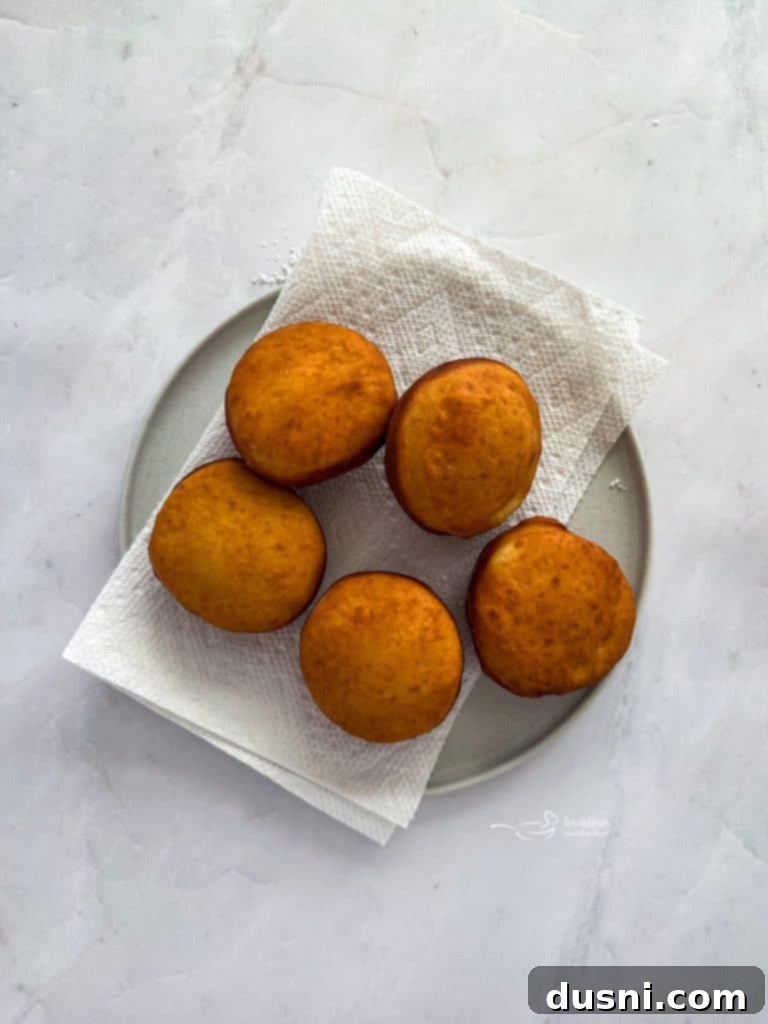
Step 7: Frying the Pączki. Heat the oil in your Dutch oven to 350 degrees F (175 degrees C). Using a candy thermometer is highly recommended to maintain this precise temperature, which is critical for even cooking and preventing greasy donuts. Carefully add 3-4 dough rounds to the hot oil, placing the top side (the drier side) down first. Do not overcrowd the pan, as this will lower the oil temperature. Watch them closely; when they turn a beautiful golden brown on one side, typically after 1-2 minutes, use a flat-slotted spoon or tongs to gently flip them over. Continue frying until they are golden brown on both sides and have puffed up nicely. This usually takes another 1-2 minutes per side. Carefully remove the fried pączki from the oil, allowing any excess oil to drip off, and place them immediately into the paper towel-lined bowl to drain further.
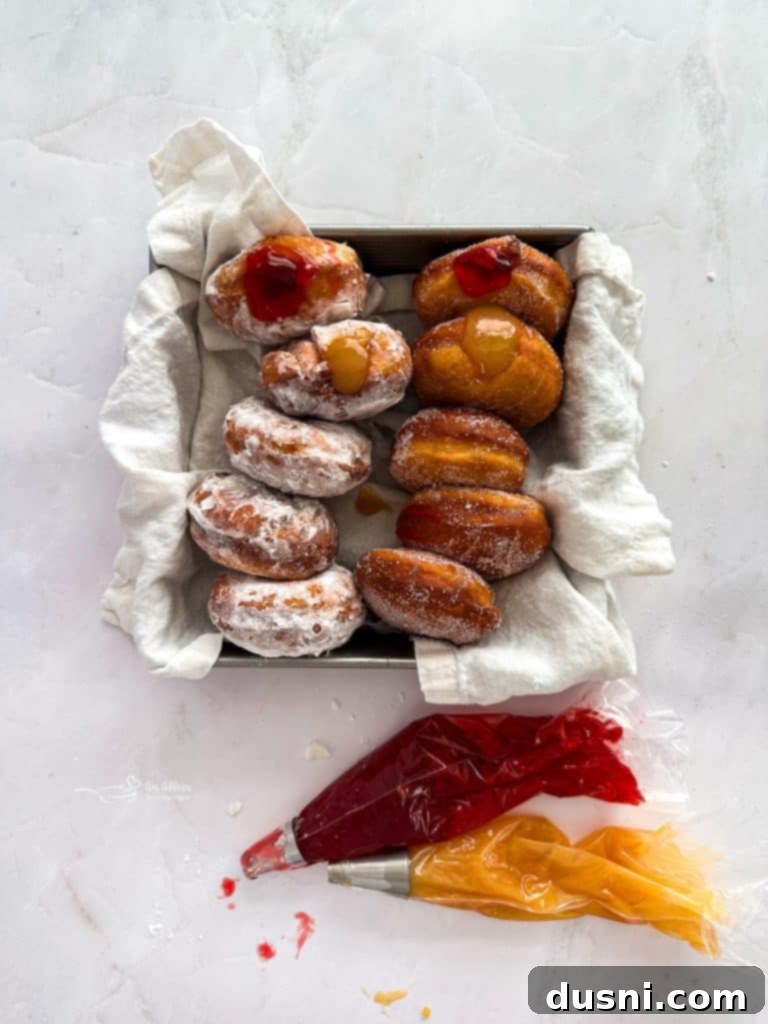
Step 8: Sugar Coating and Filling. While the pączki are still warm enough to handle comfortably, but not scalding hot, roll them generously in your chosen sugar coating (granulated or confectioners’ sugar). The residual heat helps the sugar adhere perfectly. Once coated, take a sharp knife or a wooden skewer and gently poke a hole into the side of each pączek, creating a small pocket for the filling. Insert the piping bag tip into this hole and fill generously with your preferred jam or custard. The more filling, the better! These Polish donuts are truly best enjoyed fresh and warm, ideally on the same day they are made.
Storage and Freezing Tips for Pączki
For optimal freshness and flavor, pączki are best enjoyed immediately after they are made. If you have leftovers, store them in an airtight container at room temperature for up to 3 days. When storing, avoid wrapping them too tightly in plastic wrap, as this can trap moisture and cause the sugar coating to become wet and sticky. If you wish to preserve them for longer, pączki freeze exceptionally well. Wrap them tightly in plastic wrap, then place them in an airtight freezer-safe container or bag. They can be frozen for up to 3 months. To enjoy, simply thaw them on the kitchen counter for about 30 minutes, or gently warm them in a low oven for a few minutes for a freshly-fried experience.
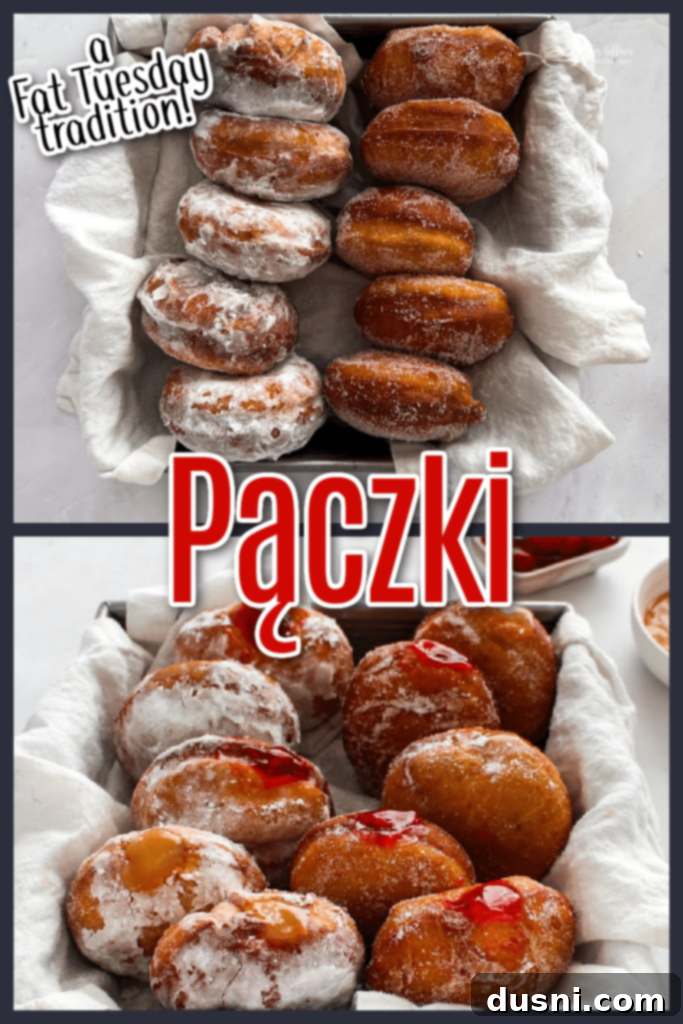
Love This Recipe? Pin It for Later!
If you’re as enamored with this traditional Polish Donut Recipe as we are, make sure you don’t lose track of it! Pin it to your favorite Pinterest recipe board before you go so you can easily find it whenever the craving for homemade Pączki strikes again!
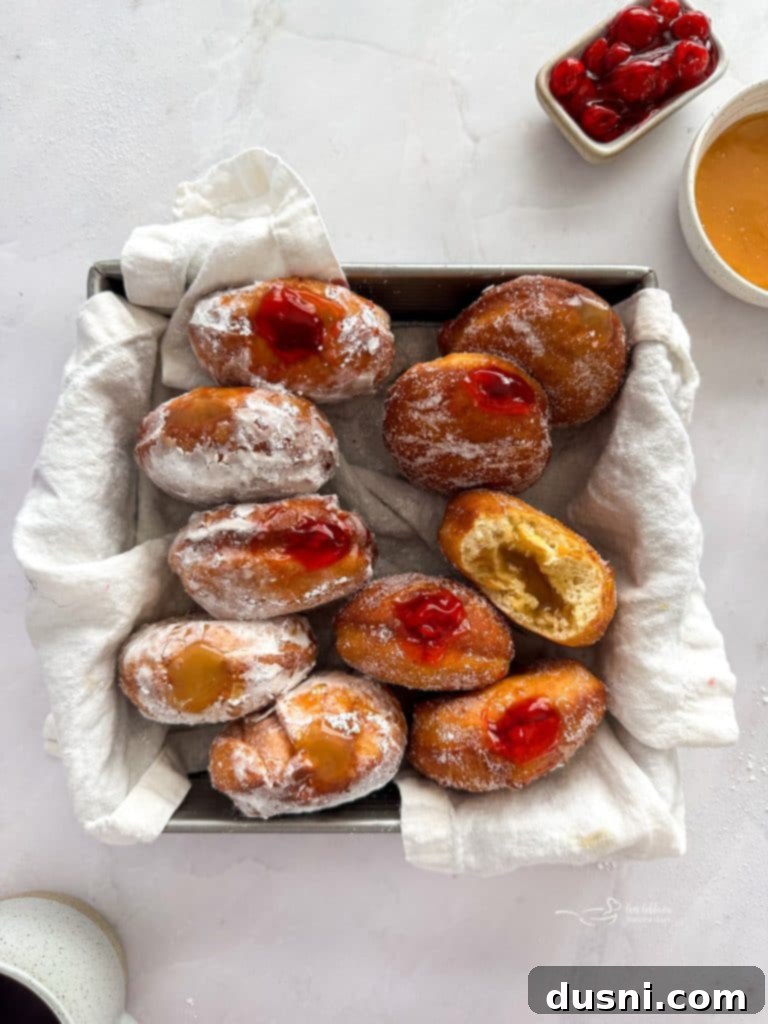
Frequently Asked Questions About Pączki
- What is the difference between a donut and a pączki? Pączki stand apart from standard donuts primarily due to their dough. They contain significantly more eggs, butter, and often sugar, making them much richer, denser, and more indulgent. Additionally, pączki are almost always filled with sweet preserves or creams, unlike many American-style donuts that can be plain or simply glazed.
- What’s the difference between a pączki and a jelly donut? While both are filled with sweet centers, pączki boast a richer dough that incorporates more eggs and butter. This results in a denser, more substantial, and almost brioche-like texture compared to the lighter, often airier dough of a typical jelly donut. The filling in a pączek is also traditionally more generous.
- What is the difference between Pączki and Bismarck? Bismarcks, also known as Berliners, are a type of German-style filled donut. They share similarities with pączki in that they are fried and filled, but typically, Bismarcks are made with a lighter dough, containing fewer eggs and less butter than their Polish counterparts.
- When is Pączki Day? In Poland, pączki are traditionally eaten on Tłusty Czwartek (Fat Thursday), which falls on the last Thursday before Lent. In the United States, however, the celebration of pączki has largely shifted to Fat Tuesday (Shrove Tuesday or Mardi Gras), the day immediately preceding Ash Wednesday, serving as the final day of culinary indulgence before Lent.
Expert Tips & Tricks for Perfect Pączki Every Time
- Properly Scald Milk: Heat milk in a small saucepan over medium heat until tiny bubbles begin to form around the edges, typically reaching about 180°F (82°C). This process eliminates enzymes that can interfere with yeast activity. Immediately remove from heat and allow it to cool to 110°F (43°C) before incorporating into the dough.
- Ensure an Optimal Rise: Always use fresh, active dry yeast. For the best possible rise, let your dough proof in a warm, draft-free environment. A slightly warmed (then turned off) oven or a proofing drawer can provide the perfect conditions.
- Critical Oil Temperature: Maintaining a consistent oil temperature of 350°F (175°C) is paramount for perfectly fried pączki. Use a reliable candy or deep-fry thermometer. If the oil is too cool, the pączki will absorb too much oil and become greasy. If it’s too hot, they’ll brown too quickly on the outside while remaining raw inside.
- Prevent Oil Absorption: Avoid overcrowding the frying pan. Frying too many pączki at once will drastically lower the oil temperature, leading to greasy, heavy donuts. Fry in small batches to maintain consistent heat.
- Effortless Filling: After frying, use a wooden skewer, chopstick, or the tip of a small, sharp knife to create a hole in the side of each pączek. Then, use a piping bag fitted with a long, thin decorating tip to generously inject your chosen filling into the center.
- Coat While Warm: For the sugar to adhere beautifully and evenly, roll the pączki in granulated or confectioners’ sugar while they are still warm, but cool enough to handle. The residual heat helps the sugar to melt slightly and stick to the surface.

More Delicious Donut Recipes to Love
These Pączki Polish Donuts are a truly fantastic and authentic way to celebrate Fat Tuesday and the Mardi Gras season. If you’re looking for other festive options, don’t miss my King Cake Donuts (pictured above), which capture the flavors of another beloved Mardi Gras classic in donut form. My site is a treasure trove of donut recipes, offering something for every taste and occasion. Be sure to explore my Powdered Sugar Donuts for a classic treat, these delightful Baked Banana Donuts, the cozy Glazed Pumpkin Donuts, the refreshing Cherry Limeade Baked Donuts, and these decadent Baked Chocolate Covered Strawberry Donuts before you go. There’s a donut for every mood and celebration!
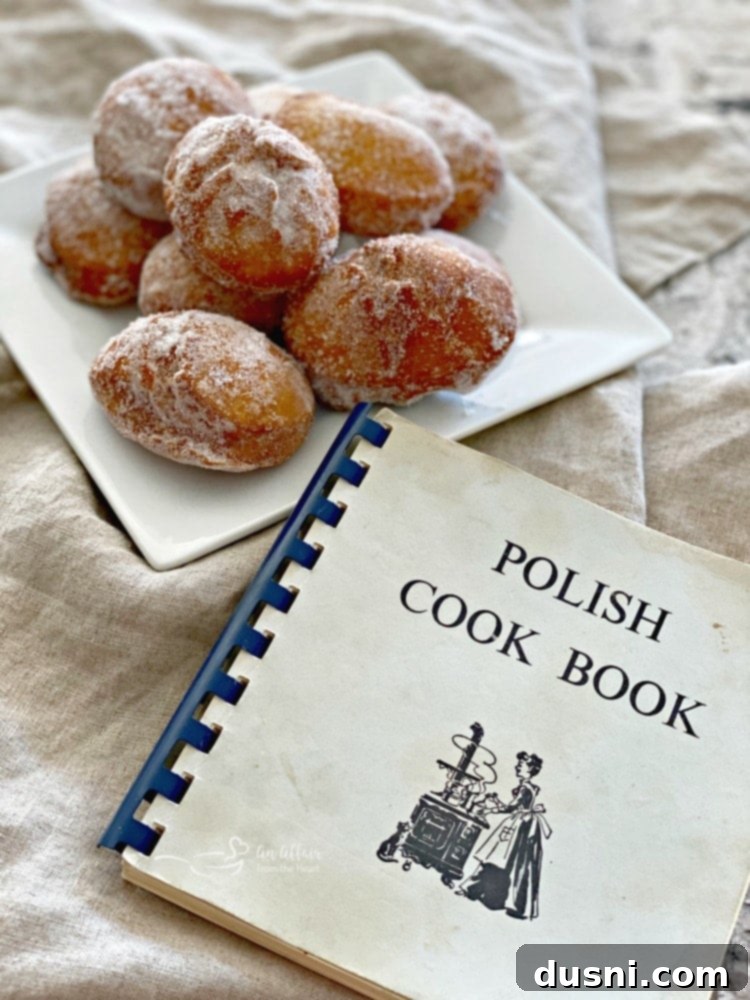
More Traditional Polish Recipes to Explore
My culinary adventures with Polish cuisine were significantly sparked by a truly special gift: an old Polish cookbook given to me by my son-in-law’s aunt. This cookbook, dating back to the 1970s, is a heartwarming compilation of recipes lovingly put together by one woman’s daughters. It’s an absolute goldmine of authentic, time-honored dishes, and it’s precisely where I discovered this incredible Pączki recipe that I’ve shared with you today.
If you’ve enjoyed making and tasting these delicious Pączki and are eager to delve deeper into the rich tapestry of Polish recipes that have been passed down through generations in our family, then here are some other traditional dishes you absolutely must check out:
- Kapuśniak (Sauerkraut Soup): A hearty and flavorful soup made with fermented cabbage, often rich with smoked meats.
- Smoked Polish Sausage & Sauerkraut: A comforting and robust dish featuring savory kielbasa simmered with tangy sauerkraut.
- Polish Noodles – Kluski Kapusta Kiszona (Polish Haluski): A simple yet incredibly satisfying dish of tender egg noodles tossed with browned cabbage or sauerkraut.
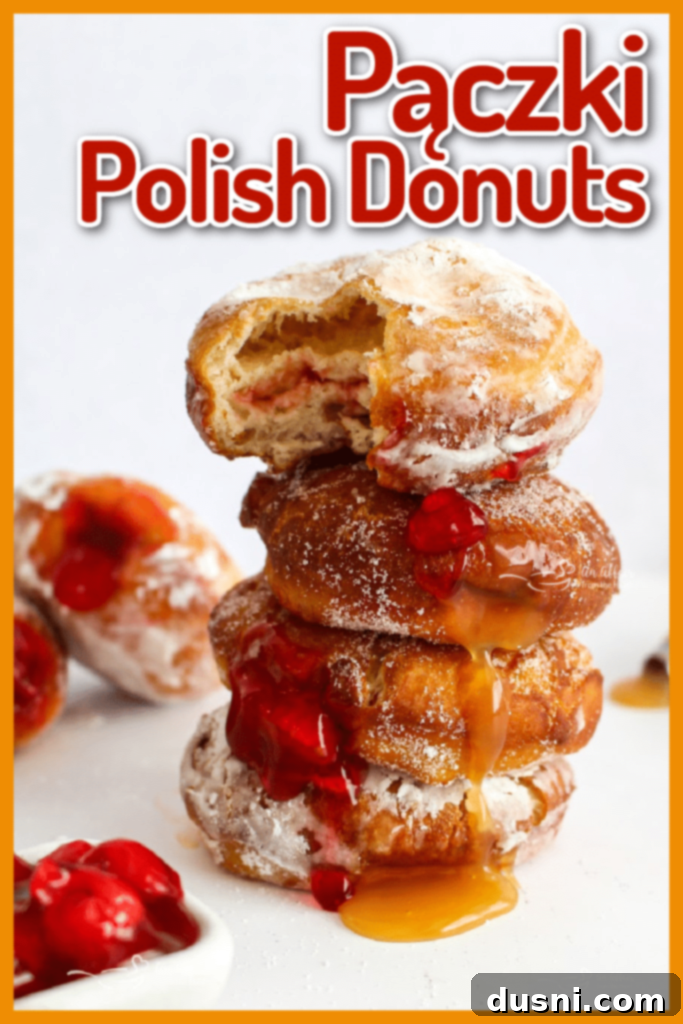
Celebrate Mardi Gras with Homemade Pączki!
There is truly nothing quite like the experience of biting into a warm, freshly made pączek on Fat Tuesday. These traditional Polish Donuts are not just a delicious pastry; they are the perfect culinary embodiment of the joy and indulgence that defines the pre-Lenten season. With their incredibly rich, buttery dough and generously sweet fillings, homemade pączki bring an authentic taste of Polish tradition directly to your Mardi Gras celebrations, wherever you are. Imagine the delight of your family and friends as they savor these unique treats, perhaps serving them alongside classic King Cakes for a truly festive and memorable spread. This tradition of deliciousness will surely be talked about until next year’s celebrations!

LIKE THIS RECIPE?
Don’t forget to give it a ⭐️⭐️⭐️⭐️⭐️ star rating and
leave a comment below the recipe!
Print Recipe
Pączki – Polish Donuts Recipe
Celebrate Fat Tuesday the way it was intended: by indulging in delicious Pączki! These traditional Polish Donuts are made from rich fried dough, lovingly dusted in sugar, and generously filled with sweet jams or creamy custards.
Prep Time: 1 hr 30 mins
Cook Time: 5 mins
Total Time: 1 hr 35 mins
Course: Donuts & Pastries
Cuisine: Polish
Keywords: Fat Thursday, Fat Tuesday, jam filled fried dough, Mardi Gras, PĄCZKI, POLISH DONUTS
Servings: 24 servings
Calories: 115kcal per serving
Author: Michaela Kenkel
Equipment You’ll Need
- Lodge 6 Quart Enameled Cast Iron Dutch Oven (Classic Red Enamel)
- Thermapen Mk4 Instant-read Thermometer
- Stand mixer with whisk and dough hook attachments
- Saucepan
- Biscuit cutter or 3-inch round glass
- Piping bag with a long, thin tip
- Cookie sheets
- Parchment paper
- Clean kitchen towels
- Large bowl lined with paper towels
Ingredients for Pączki
- 1 cup scalded milk, cooled to a lukewarm temperature of 110 degrees F.
- 1/4 cup unsalted butter, room temperature
- 1/4 cup granulated sugar
- 1/2 teaspoon vanilla extract
- 1 package active dry yeast (about 2 1/4 teaspoons)
- 3 large eggs, room temperature
- 4 cups all-purpose flour (you may need a little more or less depending on dough consistency)
- Vegetable oil for deep frying (approximately 3 inches deep in your pot)
- Jam, custard, or lemon curd for filling (your preferred choice)
- Granulated sugar or confectioners’ sugar for rolling the finished donuts
Detailed Instructions for Making Pączki
- Prepare the Milk and Yeast Mixture: In a saucepan, scald the milk by heating it over medium heat until tiny bubbles form around the edges (about 180°F). Immediately remove it from the heat and let it cool until it reaches 110°F. In the bowl of your stand mixer, combine the cooled milk, room temperature butter, sugar, and vanilla. Using the whisk attachment, mix on low speed until the sugar is fully dissolved and the butter is smoothly incorporated. Sprinkle the active dry yeast over this mixture and mix again until it completely dissolves.
- Incorporate Eggs: Scrape down the sides of the mixing bowl with a rubber spatula. Add the large eggs one at a time, mixing thoroughly after each addition until each egg is fully combined into the rich dough mixture.
- Form the Dough: Replace the whisk attachment with the dough hook on your stand mixer. With the mixer on low speed (around speed 2), gradually add the all-purpose flour to the milk mixture, a little at a time. Continue to mix until the dough becomes smooth, elastic, and pulls away cleanly from the sides of the bowl. Be mindful that the exact amount of flour needed can vary slightly; adjust as necessary to achieve a soft, pliable dough.
- First Dough Rise: Remove the dough ball from the mixer. Lightly spray the inside of the mixer bowl with non-stick cooking spray, then return the dough ball to the bowl. Spray the top of the dough ball with a little more non-stick spray to prevent a skin from forming. Cover the bowl with a clean kitchen towel or plastic wrap. Place the covered bowl in a warm, draft-free spot (such as a warm oven that has been turned off) and allow the dough to rise for 1 hour, or until it has visibly doubled in size.
- Roll and Cut Pączki Rounds: Once the dough has risen, gently punch it down to release the air. Transfer portions of the dough to a lightly floured surface. Using a rolling pin, roll the dough out evenly to a thickness of approximately 1/2-inch to 3/4-inch. Use a 3-inch biscuit cutter or a similarly sized glass to cut out individual dough circles. Gather any dough scraps, gently re-roll them, and continue cutting until all the dough is used. Carefully transfer the cut dough rounds to a cookie sheet lined with parchment paper, ensuring there is a little space between each one.
- Second Dough Rise: Lightly cover the cookie sheet containing the cut dough rounds with a clean kitchen towel. Allow them to rise again for another 30 minutes in a warm, draft-free location. This second rise is crucial for developing the light texture and the signature “white ring” when fried.
- Prepare Frying Station: While the dough undergoes its second rise, prepare your frying setup. Fill a cast iron Dutch oven or other heavy-bottomed pot with about 3 inches of vegetable oil. Gather your chosen sugar for coating (granulated or confectioners’ sugar). Prepare your desired filling (jam, custard, or lemon curd) by placing it into a piping bag fitted with a long, thin tip. Line a large bowl with several layers of paper towels to drain the fried pączki.
- Fry the Pączki: Heat the vegetable oil in your Dutch oven to 350°F (175°C). Use a candy thermometer to monitor and maintain this temperature accurately. Carefully add about 3-4 dough rounds to the hot oil, ensuring not to overcrowd the pan. Place the top (drier) side of the dough down first. Fry for 1-2 minutes per side, watching closely and flipping them with a flat-slotted spoon or tongs when they turn a beautiful golden brown. Continue frying until they are golden on both sides and have puffed up. Remove the fried pączki and place them in the paper towel-lined bowl to drain excess oil.
- Coat and Fill: When the pączki are still warm enough to handle but not scalding hot, roll them generously in your chosen sugar coating. The residual heat helps the sugar adhere perfectly. Using a sharp knife or wooden skewer, poke a hole into the side of each pączek. Insert the piping bag tip into this hole and fill generously with your chosen jam or custard.
- Serve and Store: These Polish donuts are truly best enjoyed fresh and warm on the first day they are made. If you have any leftovers, store them in an airtight container for up to 3 days. Avoid wrapping them too tightly, as this can make the sugar coating damp. Pączki also freeze well; wrap them tightly in an airtight container and freeze for up to 3 months. Simply thaw on the counter for 30 minutes to enjoy.
Nutrition Information for Pączki
Serving: 1
Calories: 115kcal
Carbohydrates: 19g
Protein: 3g
Fat: 3g
Saturated Fat: 2g
Polyunsaturated Fat: 0.3g
Monounsaturated Fat: 1g
Trans Fat: 0.1g
Cholesterol: 27mg
Sodium: 27mg
Potassium: 46mg
Fiber: 1g
Sugar: 3g
Vitamin A: 105IU
Calcium: 19mg
Iron: 1mg
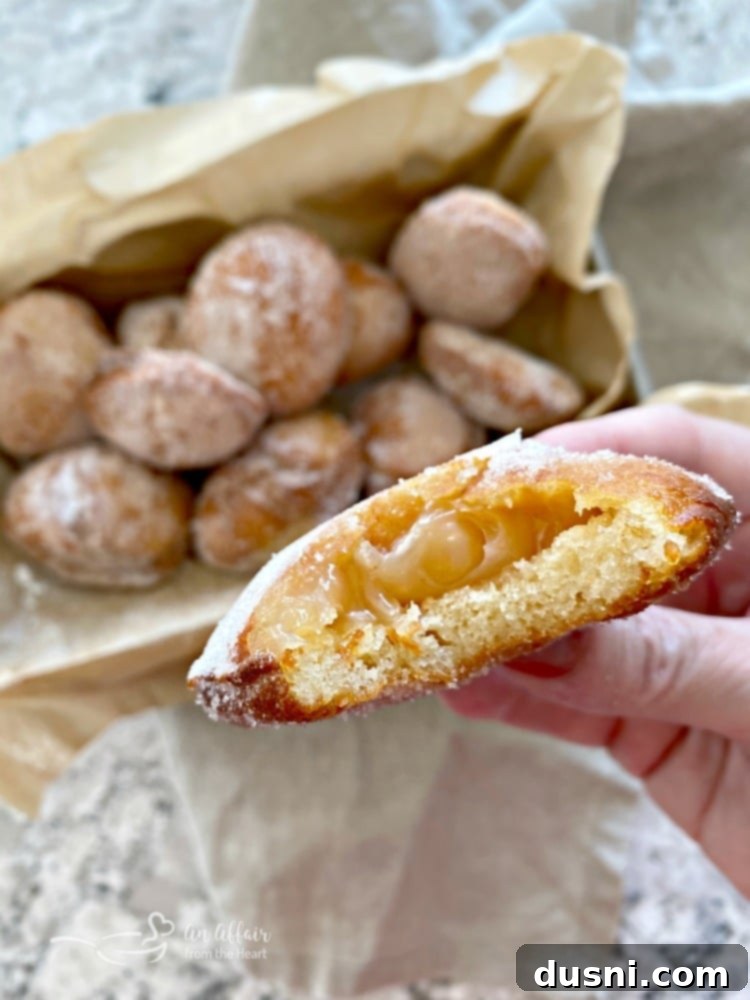
This recipe was originally posted on February 21, 2020. It has been updated to improve user experience and reshared on February 20, 2025.
